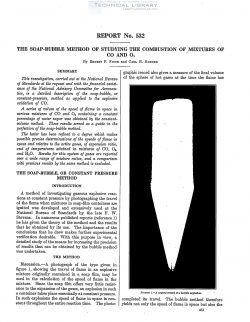naca-report-532

- Version
- 153 Downloads
- 1.32 MB File Size
- 1 File Count
- August 30, 2016 Create Date
- August 30, 2016 Last Updated
National Advisory Committee for Aeronautics, Report - The Soap Bubble method of Studying the Combustion of Mixtures of CO and O2

This investigation, carried out at the National Bureau
of Standards at the request and with the financial assist—
ance of the National Advisory Committee for Aeronau-
tics, is a detailed description of the soap-bubble, or
constant-pressure, method as applied to the eaplosive
oxidation of CO.
A series of values of the speed of flame in space in
various mixtures of CO and 02 containing a constant
percentage of water vapor was obtained by the constant-
volume method. These results served as a guide in the
perfection of the soap-bubble method.
The latter has been refined to a degree which makes
possible precise determinations of the speeds of flame in
space and relative to the active gases, of expansion ratio,
and of temperatures attained in mixtures of CO, 02,
and H20. Results for this system of gases are reported
over a wide range of mixture ratios, and a comparison
with previous results by the same method is included.
A method of investigating gaseous explosive reac-
tions at constant pressure by photographing the travel
of the flame when mixtures in soap-film containers are
ignited was developed and‘extensively used at the
National Bureau of Standards by the late F. W.
Stevens. In numerous published reports (reference 1)
he has given the theory of the method and the results
that he obtained by its use. The importance of the
conclusions that he drew makes further experimental
verification desirable. With this purpose in view, a
detailed study of the means for increasing the precision
of results that can be obtained by the bubble method
was undertaken.
Discussion—A photograph of the type given in
figure 1, showing the travel of flame in an explosive
mixture originally contained in a soap film, may be
used in the calculation of the speed of flame in the
mixture. Since the soap film ofl‘ers very little resist-
ance to the expansion of the gases, an explosion in such
a container takes place essentially at constant pressure.
In such explosions the speed of flame in space is con-
stant throughout the entire reaction time.
| File | Action |
|---|---|
| naca-report-532 The Soap Bubble method of Studying the Combustion of Mixtures of CO and O2.pdf | Download |

Comment On This Post